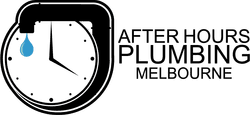It’s 2 AM on a Sunday when you wake to the sound of rushing water. You stumble out of bed to find water cascading from under your bathroom door. A pipe has burst, and water is quickly spreading across your home. In this moment, knowing how to turn off your water at the mains isn’t just useful - it’s going to save you a lot of money and stress.
Water emergencies don’t wait for convenient times, and the difference between minor damage and a devastating flood often comes down to how quickly you can shut off your main water supply. I’ll walk you through finding your main water shut off valve in your house in Australia, understanding different valve types, and providing clear steps on how to turn off water from your main line. This knowledge could save you thousands in water damage and buy crucial time until professional help arrives.
Why You Need to Know How to Turn Off Your Water Mains
Understanding how to turn off water mains at home is a fundamental skill every Australian homeowner should master. When water is flowing uncontrollably through your home, quick action is required. A burst pipe can release hundreds of litres of water in minutes, causing extensive damage to floors, walls, furniture, and personal belongings. Appliance failures, such as washing machine hose ruptures or dishwasher leaks, can similarly flood your home without warning.
Beyond emergencies, many routine plumbing projects require turning off your water supply. Whether you’re replacing taps, installing new appliances, upgrading plumbing systems, or performing regular maintenance, knowing how to shut off your water supply is necessary. Professional plumbers can handle these tasks, but understanding how to turn off your mains water gives you immediate control in urgent situations.
The financial implications of water damage are significant. Water damage repairs in Australia typically range from $5,000 to over $30,000 depending on severity. This doesn’t account for the emotional toll of losing irreplaceable personal items or the disruption to your daily life. Being able to quickly locate where your mains water shut off is and operate it properly could dramatically reduce this impact.
Where to Find Your Main Water Shut Off Valve in Your House in Australia
The location of your water main shut off valve varies according to your property type, and identifying it before an emergency occurs is crucial. For most detached suburban homes, the water meter and main shut-off valve are located in the front garden near the boundary line. Look for a small black or green box or a metal/plastic cover in the ground, often situated in garden beds or lawns near the street. Sometimes these are located under the driveway and are usually marked with a water company symbol or simply labeled “Water.”
If you live in a unit or townhouse, your water main might be at the rear of the property. There may be a bank of meters serving multiple units, so you’ll need to identify the valve that isolates just your property. In some cases, you may need to check common areas if you can’t find it near your unit.
For apartment dwellers, the main shut-off valve is typically located in the underground car park if available. Each should display the apartment number it serves. If you can’t access the main valve, check for internal isolation valves, which are common in apartment buildings.
Many Australian homes also have indoor isolation valves that won’t shut off your entire water supply but can stop water to specific areas. These are typically located next to toilets, under laundry tubs, under kitchen sinks, or near hot water systems. While these aren’t the main water shut off, they can be useful for isolated leaks in specific fixtures.
Understanding Different Types of Water Main Valves in Australia
In Australian homes, you’ll typically encounter three main types of water shut-off valves, each requiring a different approach to operate. Understanding which type you have will help you act quickly when needed.
Ball valves are the most modern and user-friendly option, featuring a single lever handle that requires only a quarter turn (90 degrees) to turn off. When the handle is parallel to the pipe, water flows freely; when the handle is perpendicular to the pipe, water is shut off. These valves are generally the easiest to operate, even for those with limited strength or mobility.
T-top isolation taps are common in many Australian homes, particularly older properties. They have a distinctive T-shaped handle and require turning clockwise to shut off. Unlike ball valves, T-top valves typically need multiple turns to fully close. These can sometimes become stiff with age and might require a bit more force to operate.
Gate valves feature a wheel-shaped handle and are more common in older Australian properties. They require multiple complete turns in a clockwise direction until they won’t turn anymore. These valves operate by lowering a gate or barrier inside the pipe to block water flow. Gate valves are more prone to corrosion and may become increasingly difficult to turn over time due to mineral deposits and disuse.
Identifying which type of valve controls your water supply before an emergency occurs will save precious time when it matters most. Consider taking a photo of your valve for reference and showing family members how to operate it properly.
Step-by-Step Guide: How to Turn Off Your Water Mains
Now let’s walk through exactly how to turn off water from your main line with detailed guidance for each step of the process.
1. Locate Your Water Meter
First, use the guidance above based on your property type to find your water meter. For most standalone homes, check your front yard near the property boundary. The water meter is typically housed in a protective box set into the ground. In newer developments, these boxes are usually made of black or green plastic, while older properties might have concrete or metal covers.
If you’re having trouble locating your meter, check your property plans or contact your local water authority for assistance. Some water suppliers even offer online resources showing typical meter locations for your area. It’s worth spending time locating this before any emergency occurs.
2. Access the Water Meter Box
Once you’ve found the meter box, you’ll need to open it to access the shut-off valve. If there’s a council cover plate, you may need a flathead screwdriver to pry it open. Insert the screwdriver into the small groove or hole in the cover and carefully lift. Some covers simply lift off without tools, particularly newer plastic varieties.
Be cautious when opening the box, as spiders, insects, or even snakes occasionally make these spaces their home in Australia. If it’s been raining, the meter box might contain water. You may need to bail this out with a cup or small container to clearly see and access the valve. Having a torch handy is also useful, especially if you’re dealing with an emergency at night.
3. Identify the Shut-Off Valve
Inside the meter box, you’ll see your water meter and the shut-off valve. The valve will typically be on the property side of the water meter (the side closest to your house). Take a moment to identify which type of valve you have based on the descriptions provided earlier-whether it’s a lever handle (ball valve), a T-shaped handle (T-top isolation tap), or a wheel-shaped handle (gate valve).
The meter itself will have numbers that track your water usage and may have a small triangle or dial that rotates when water is flowing. This flow indicator can be useful when checking if your water is completely turned off after closing the valve.
4. Turn Off the Water Supply
Now it’s time to turn off your water at the mains. The process varies slightly depending on your valve type:
For ball valves, grasp the lever firmly and turn it 90 degrees (a quarter turn) so that it’s perpendicular to the pipe. When properly closed, the handle will be crossing the direction of the pipe rather than running alongside it. These valves shut off quickly, so be prepared for a sudden stop of water flow.
If you have a T-top isolation tap, grip the T-shaped handle and turn it clockwise (to the right) as far as it will go. These valves typically require several complete turns to fully close. Keep turning until you feel resistance and the handle won’t turn any further. Avoid using excessive force that might damage the valve.
For gate valves with their wheel-shaped handles, turn the wheel clockwise until it stops turning. These valves require multiple complete turns-sometimes as many as 10 to 20 rotations-to fully close. Be patient and keep turning until you meet resistance.
If the valve is difficult to move, which is common with older valves that haven’t been operated in years, try wearing gloves for better grip. If necessary, use pliers or an adjustable wrench to carefully turn the valve. Apply even, steady pressure rather than jerky movements that could damage the valve. Never force a valve that won’t move with reasonable pressure-this could break it and create an even bigger problem.
5. Verify the Water is Off
After closing the valve, you need to confirm that you’ve successfully turned off the water supply. The most effective way to do this is to test a tap in your home.
First, go to an outside tap if available, as these are typically closest to your water main. Turn it on fully and allow any remaining water in the pipes to drain out. Water should stop flowing within a few seconds to a minute, depending on the amount of water already in your pipes and the water pressure.
Next, check an indoor tap to confirm no water is flowing. Remember that some water may still drain from the pipes even after the main valve is closed. This residual water can take a minute or two to completely drain, especially from upper floors in multi-level homes.
If water continues running after several minutes, it could indicate that the valve hasn’t fully closed or that you’ve turned off an isolation valve rather than the main water supply. Double-check your valve position and try turning it again if necessary.
6. What to Do If the Valve Won’t Turn
Encountering a stuck valve is not uncommon, especially in older homes or properties where the valve hasn’t been operated for years. If you can’t turn your water main shut-off valve, resist the urge to force it, as this could break the valve and potentially cause more serious problems.
Instead, try using a cloth for better grip, which can help with slightly stiff valves. For valves that appear corroded, applying a small amount of penetrating oil to the valve stem might help loosen it. Allow the oil to penetrate for a few minutes before attempting to turn the valve again.
If these methods don’t work, it’s time to call a licensed plumber immediately. Professional plumbers have specialised tools to deal with stuck valves without causing damage. They can also advise on whether the valve needs replacement, which is often recommended for severely corroded or damaged valves.
In the meantime, if water is flowing uncontrollably in your home, try to contain it as best you can. Use buckets, towels, and containers to collect water, and move valuable items to higher ground or out of the affected area. If flooding is severe, you may need to turn off electricity to affected areas of your home for safety.
When to Call a Professional Plumber
While knowing how to turn off your mains water is essential for every Australian homeowner, there are situations where professional assistance is necessary. If you can’t locate your water meter or shut-off valve despite your best efforts, a licensed plumber can help identify it and potentially mark it for future reference.
When faced with a damaged or seized valve that won’t turn despite careful attempts, professional intervention is required. Forcing a stubborn valve can lead to breaks that worsen the situation. Similarly, if turning off the main valve doesn’t stop the water flow, this could indicate more complex plumbing issues that need expert diagnosis.
Professional plumbers can also provide valuable ongoing maintenance and valve servicing. They can replace worn washers, lubricate stiff mechanisms, and identify potential issues before they become emergencies. Many plumbers recommend having your main valve inspected every few years to ensure it will function properly when needed.
After shutting off water due to an emergency, you’ll need professional assistance to repair the underlying problem, whether it’s a burst pipe, failed fixture, or damaged appliance connection. Licensed plumbers have the tools, parts, and expertise to make lasting repairs that prevent future issues.
Maintenance Tips for Your Water Main Valve
To ensure your water main functions properly when needed, regular maintenance is essential. Test your shut-off valve every 6-12 months by turning it off and on again. This prevents the valve from seizing due to mineral buildup and ensures it will operate smoothly in an emergency. Make this part of your regular home maintenance routine, perhaps when you test smoke detectors or change air filters.
Keep the meter box clear of debris, soil, and vegetation to ensure easy access when needed. In some areas, meter boxes can become overgrown or partially buried over time. Regularly check that your meter box is visible and accessible, clearing away any obstructions.
For very old or difficult-to-turn valves, consider having them professionally replaced before they fail completely. Modern ball valves are more reliable and easier to operate than older gate valves or T-top taps. This preventative measure can save significant stress during emergencies.
Mark the location of your water meter for quick access in emergencies. This is particularly important if your meter box is not clearly visible or is covered by landscaping. Consider placing a small marker or distinctive plant near the meter box, and make sure all household members know where to find it.
Creating a simple home emergency plan that includes the location of your water shut-off valve and basic instructions for turning it off can be invaluable. Keep this information in an easily accessible location and review it periodically with everyone in your household.
Be Prepared: Know How to Turn Off Your Water Mains Before Emergencies Happen
Water damage from burst pipes or major leaks can devastate your home in minutes. Knowing where your mains water shut off is located and how to operate it properly is an essential skill that can prevent extensive damage, save thousands in repair costs, and provide peace of mind during plumbing emergencies.
Take time today to locate your main water valve, understand how it works, and practice turning it off. Show other household members how to operate it as well. This simple preparation could be the difference between a minor inconvenience and a major disaster.
Remember that water main valves can become stiff or difficult to turn over time. If you notice your valve becoming harder to operate during your regular maintenance checks, consider having it serviced or replaced before it becomes completely seized.
For assistance with water emergencies, valve maintenance, or any plumbing needs, our team of licensed professionals is available 24/7. We provide fast, reliable service to minimise damage and restore your plumbing system efficiently. Our plumbers can also help identify your main water valve, mark it clearly, and ensure it’s functioning properly for when you need it most.
Don’t wait for a plumbing catastrophe to discover your water shut-off valve doesn’t work or to learn how to turn off water from your main line. Contact us today for a preventative maintenance check of your water main or for immediate assistance with any plumbing emergency.
Frequently asked questions
Where is my main water shut-off valve located in Australia?
What type of water shut-off valve does my home have?
How can I confirm that the water is turned off?
What should I do if the valve is stuck and won’t turn?
How often should I check or maintain my shut-off valve?
Emergency Water Shut-Off Checklist
Keep this quick reference guide handy for water emergencies:
- Go to your water meter (usually near your property boundary)
- Open the meter box (use a screwdriver if needed)
- Locate the shut-off valve on the house side of the meter
- Turn clockwise to shut off (90 degrees for ball valves, multiple turns for others)
- Test a tap to confirm water is off
- Call your plumber for repairs
- Begin water cleanup to minimize damage
Our licensed plumbers specialise in emergency water valve services, maintenance and testing of main shut-off valves, valve replacement and upgrades, and 24/7 emergency response for water leaks and burst pipes. We serve all metropolitan areas with prompt, professional service when you need it most.
More articles











































